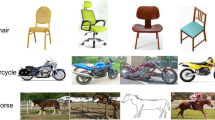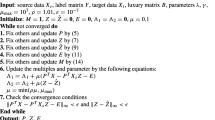Abstract
Transfer learning is proposed to solve a general problem in practical applications faced by traditional machine learning methods, that is, the training and test data have different distributions. This paper provides a novel transfer subspace learning method combining low-rank representation (LRR) and feature selection for unsupervised domain adaptation. The core of the proposed method is to map both the source and target data into a latent subspace by a projection such that the discrepancy between domains is reduced. Specifically, by using LRR, a low-rank constraint is imposed on the reconstruction coefficient matrix, and thus the global structure of data can be preserved. Moreover, a structured sparsity-inducing norm based regularization term is introduced into the domain adaptation, which leads to imposing a row-sparsity constraint on the projection matrix. This constraint can enforce rows of the projection matrix corresponding to inessential feature attributes to be all zeros, and thus select relevant features across two domains. As a result, the proposed method has good interpretability and can adaptively perform feature selection. Furthermore, taking into account that the projected samples should be close to each other in the shared subspace if they belong to the same class, regardless of which domain they originally come from, we introduce graph embedding to characterize the local manifold structures of data so as to preserve the relationships between examples in the subspace. Finally, we mathematically formulate the proposed method and derive an iterative algorithm to solve the corresponding problem. The exhaustive experimental evaluations on public datasets confirm the effectiveness of the proposed method in comparison with several state-of-the-art methods.







Similar content being viewed by others
References
Belkin M, Niyogi P (2002) Semi-supervised learning on manifolds. In: Proceedings of NIPS, pp 1–23
Blum A, Chawla S (2001) Learning from labeled and unlabeled data using graph mincuts. In: Proceedings of ICML, pp 19–26
Busto PP, Iqbal A, Gall J (2020) Open set domain adaptation for image and action recognition. IEEE Trans Pattern Anal Mach Intell 42(2):413–429
Cai J, Candès EJ, Shen Z (2010) A singular value thresholding algorithm for matrix completion. SIAM J Optim 20(4):1956–1982
Chen W, Hsu TH, Tsai YH, Chen M, Wang Y (2019) Transfer neural trees: Semi-supervised heterogeneous domain adaptation and beyond. IEEE Trans Image Process 28(9):4620–4633
Duan L, Tsang IW, Xu D, Maybank SJ (2009) Domain transfer SVM for video concept detection. In: Proceedings of IEEE CVPR, pp 1375–1381
Ganin Y, Ustinova E, Ajakan H, Germain P, Larochelle H, Laviolette F, Marchand M, Lempitsky V (2016) Domain-adversarial training of neural networks. J Mach Learn Res 17(1):1–35
Ghifary M, Balduzzi D, Kleijn WB, Zhang M (2017) Scatter component analysis: a unified framework for domain adaptation and domain generalization. IEEE Trans Pattern Anal Mach Intell 39(7):1414–1430
Gong B, Grauman K, Sha F (2013) Connecting the dots with landmarks: Discriminatively learning domain-invariant features for unsupervised domain adaptation. In: Proceedings of ICML, pp 153–159
Gong B, Shi Y, Sha F, Grauman K (2012) Geodesic flow kernel for unsupervised domain adaptation. In: Proceedings of IEEE CVPR, pp 2066–2073
Gopalan R, Li R, Chellappa R (2011) Domain adaptation for object recognition: An unsupervised approach. In: Proceedings of IEEE ICCV, pp 999–1006
Gretton A, Borgwardt KM, Rasch MJ, Schölkopf B, Smola A (2012) A kernel two-sample test. J Mach Learn Res 13:723–773
He F, Nie F, Wang R, Li X, Jia W (2020) Fast semisupervised learning with bipartite graph for large-scale data. IEEE Trans Neural Netw Learn Syst 31(2):626–638
He Z, Yang B, Chen C, Mu Q, Li Z (2020) CLDA: An Adversarial unsupervised domain adaptation method with classifier-level adaptation. Multimedia Tools and Applications
Jhuo IH, Liu D, Lee DT, Chang SF (2012) Robust visual domain adaptation with low-rank reconstruction. In: Proceedings of IEEE CVPR, pp 2168–2175
Jie N, Qiang Q, Chellappa R (2013) Subspace interpolation via dictionary learning for unsupervised domain adaptation. In: Proceedings of IEEE CVPR, pp 692–699
Jing M, Li J, Lu K, Zhu L, Yang Y (2020) Learning explicitly transferable representations for domain adaptation. Neural Netw 130:39–48
Krizhevsky A, Sutskever I, Hinton GE (2012) ImageNet classification with deep convolutional neural networks. In: Proceedings of NIPS, pp 1097–1105
Liu G, Lin Z, Yan S, Sun J, Yu Y, Ma Y (2013) Robust recovery of subspace structures by low-rank representation. IEEE Trans Pattern Anal Mach Intell 35(1):171–184
Liu G, Lin Z, Yu Y (2010) Robust subspace segmentation by low-rank representation. In: Proceedings of ICML, pp 663–670
Liu F, Lu J, Zhang G (2018) Unsupervised heterogeneous domain adaptation via shared fuzzy equivalence relations. IEEE Trans Fuzzy Syst 26(6):3555–3568
Liu F, Zhang G, Lu J (2020) Heterogeneous domain adaptation: an unsupervised approach. IEEE Trans Neural Netw Learn Syst 31(12):5588–5602
Long M, Cao Y, Wang J, Jordan MI (2015) Learning transferable features with deep adaptation networks. In: Proceedings of ACM ICML, pp 97–105
Long M, Cao Z, Wang J, Jordan MI (2018) Conditional adversarial domain adaptation. In: Proceedings of NeurIPS, pp 1640–1650
Long M, Wang J, Ding G, Sun J, Yu PS (2013) Transfer feature learning with joint distribution adaptation. In: Proceedings of IEEE ICCV pp 2200–2207
Long M, Wang J, Ding G, Sun J, Yu PS (2014) Transfer joint matching for unsupervised domain adaptation. In: Proceedings of IEEE CVPR, pp 1410–1417
Lu H, Shen C, Cao Z, Xiao Y, Henge A (2018) An embarrassingly simple approach to visual domain adaptation. IEEE Trans Image Process 27(7):3403–3417
Luo L, Chen L, Hu S, Lu Y, Wang X (2020) Discriminative and geometry-aware unsupervised domain adaptation. IEEE Trans Cybern 50 (9):3914–3927
Pan SJ, Tsang IW, Kwol JT, Yang Q (2011) Domain adaptation via transfer component analysis. IEEE Trans Neural Netw 22(2):199–210
Pan SJ, Yang Q (2009) A survey on transfer learning. IEEE Trans Knowl Data Eng 22(10):1345–1359
Peng J, Sun W, Ma L, Du Q (2019) Discriminative transfer joint matching for domain adaptation in hyperspectral image classification. IEEE Geosci Remote Sens Lett 16(6):972–976
Pereira LAM, Torres RDS (2018) Semi-supervised transfer subspace for domain adaptation. Pattern Recognit 75:235–249
Razzaghi P, Razzaghi P, Abbasi K (2019) Transfer subspace learning via low-rank and discriminative reconstruction matrix. Knowl-Based Syst 163:174–185
Shao M, Kit D, Fu Y (2014) Generalized transfer subspace learning through low-rank constraint. Int J Comput Vis 109(1):74–93
Si S, Tao D, Geng B (2010) Bregman divergence-based regularization for transfer subspace learning. IEEE Trans Knowl Data Eng 22(7):929–942
Tahmoresnezhad J, Hashemi S (2017) Visual domain adaptation via transfer feature learning. Knowl Inf Syst 50:585–605
Tzeng E, Hoffman J, Zhang N, Saenko K, Darrell T (2014) Deep domain confusion: Maximizing for domain invariance, arXiv:1412.3474
Wang J, Chen Y, Hao S, Feng W, Shen Z (2017) Balanced distribution adaptation for transfer learning. In: Proceedings of IEEE ICDM, pp 1129–1134
Wang Y, Nie L, Li Y, Chen S (2020) Soft large margin clustering for unsupervised domain adaptation. Knowl-Based Syst 192:105344
Wang W, Wang H, Zhang Z, Zhang C, Gao Y (2019) Semi-supervised domain adaptation via Fredholm integral based kernel methods. Pattern Recognit 85:185–197
Xiang S, Nie F, Meng G, Pan C, Zhang C (2012) Discriminative least squares regression for multiclass classification and feature selection. IEEE Trans Neural Netw Learn Syst 23(11):1738–1754
Xie Y, Du Z, Li J, Jing M, Chen E, Lu K (2020) Joint metric and feature representation learning for unsupervised domain adaptation. Knowl-Based Syst 192:105222
Xu Y, Fang X, Wu J, Li X, Zhang D (2016) Discriminative transfer subspace learning via low-rank and sparse representation. IEEE Trans Images Process 25(2):850–863
Xu F, Yu J, Xia R (2018) Instance-based domain adaptation via multiclustering logistic approximation. IEEE Intell Syst 33(1):78–88
Yan H, Li Z, Wang Q, Li P, Xu Y, Zuo W (2020) Weighted and class-specific maximum mean discrepancy for unsupervised domain adaptation. IEEE Trans Multi 22(9):2420–2433
Yang L, Men M, Xue Y, Zhong P (2020) Low-rank representation-based regularized subspace learning method for unsupervised domain adaptation. Multimed Tools Appl 79:3031–3047
Yang J, Yan R, Hauptmann AG (2007) Cross-domain video concept detection using adaptive SVMs. In: Proceedings of ACM MM, pp 188–197
Yang J, Yin W, Zhang Y, Wang Y (2009) A fast algorithm for edge-preserving variational multichannel image restoration. SIAM J Imaging Sci 2(2):569–592
Yang L, Zhong P (2020) Discriminative and informative joint distribution adaptation for unsupervised domain adaptation. Knowl-Based Syst 207:106394
Yao Y, Li X, Ye Y, Liu F, Ng MK, Zhang Y (2019) Low-resolution image categorization via heterogeneous domain adaptation. Knowl-Based Syst 163:656–665
Zhang J, Hu H (2019) Domain learning joint with semantic adaptation for human action recognition. Pattern Recognit 90:196–209
Zhang L, Wang P, Wei W, Lu H, Shen C, Hengel AVD, Zhang Y (2019) Unsupervised domain adaptation using robust class-wise matching. IEEE Trans Circ Syst Video Technol 29(5):1339–1349
Zhang Y, Wen J, Wang X, Jiang Z (2014) Semi-supervised learning combining co-training with active learning. Expert Syst Appl 41(5):2372–2378
Zhang W, Zhang X, Lan L, Luo Z (2020) Enhancing unsupervised domain adaptation by discriminative relevance regularization. Knowl Inf Syst 62:3641–3664
Zhang Z, Zhao M, Chow TWS (2015) Graph based constrained semi-supervised learning framework via label propagation over adaptive neighborhood. IEEE Trans Knowl Data Eng 27(9):2362–2376
Acknowledgments
The authors would like to thank the editors and reviewers for their constructive comments and suggestions which can help improve the quality of the paper. This work was supported by the opening foundation of Engineering Research Center of Intelligent Computing for Complex Energy Systems, Ministry of Education. This work was also supported by the Natural Science Foundation of Guangdong province (Grant No. 2018A0303130026) and the Teacher Research Capacity Promotion Program of Beijing Normal University, Zhuhai.
Author information
Authors and Affiliations
Corresponding author
Additional information
Publisher’s note
Springer Nature remains neutral with regard to jurisdictional claims in published maps and institutional affiliations.
Rights and permissions
About this article
Cite this article
Yang, L., Zhou, Q. Transfer subspace learning joint low-rank representation and feature selection. Multimed Tools Appl 81, 38353–38373 (2022). https://doi.org/10.1007/s11042-022-12504-z
Received:
Revised:
Accepted:
Published:
Issue Date:
DOI: https://doi.org/10.1007/s11042-022-12504-z




